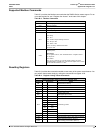
PowerLogic
TM
Series 800 Power Meter 63230-500-225A2
Appendix B—Register List 3/2011
© 2011 Schneider Electric All Rights Reserved
80
How Date and Time are Stored in Registers
The date and time are stored in a three-register compressed format. Each of the three
registers, such as registers 1810 to 1812, contain a high and low byte value to represent
the date and time in hexadecimal. Table B–1 lists the register and the portion of the date or
time it represents.
Table B–2 provides an example of the date and time. If the date was 01/25/00 at 11:06:59,
the Hex value would be 0119, 640B, 063B. Breaking it down into bytes we have the
following:
NOTE: Date format is a 3 (6-byte) register compressed format. (Year 2001 is represented
as 101 in the year byte.)
How Signed Power Factor is Stored in the Register
Each power factor value occupies one register. Power factor values are stored using
signed magnitude notation (see Figure B–2). Bit number 15, the sign bit, indicates
leading/lagging. A positive value (bit 15=0) always indicates leading. A negative value (bit
15=1) always indicates lagging. Bits 0–9 store a value in the range 0–1,000 decimal. For
example the power meter would return a leading power factor of 0.5 as 500. Divide by
1,000 to get a power factor in the range 0 to 1.000.
When the power factor is lagging, the power meter returns a high negative value—for
example, -31,794. This happens because bit 15=1 (for example, the binary equivalent of -
31,794 is 1000001111001110). To get a value in the range 0 to 1,000, you need to mask bit
15. You do this by adding 32,768 to the value. An example will help clarify.
Assume that you read a power factor value of -31,794. Convert this to a power factor in the
range 0 to 1.000, as follows:
-31,794 + 32,768 = 974
974/1,000 = .974 lagging power factor
Table B–1: Date and Time Format
Register Hi Byte Lo Byte
Register 0 Month (1-12) Day (1-31)
Register 1 Year (0-199) Hour (0-23)
Register 2 Minute (0-59) Second (0-59)
Table B–2: Date and Time Byte Example
Hexadecimal Value Hi Byte Lo Byte
0119 01 = month 19 = day
640B 64 = year 0B = hour
063B 06 = minute 3B = seconds
Figure B–2: Power Factor Register Format
1023456789101112131415
00000
Sign Bit
0=Leading
1=Lagging
Unused Bits
Set to 0
Power Factor
in the range 100-1000 (thousandths)


















